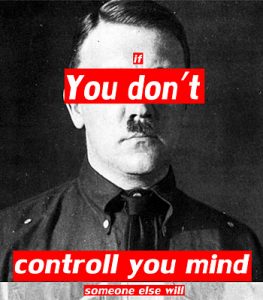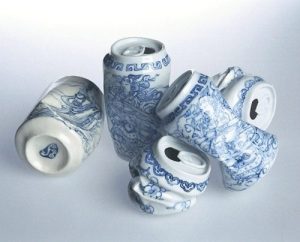
The first image I wanted to talk about is from Shepard Fairey, who makes powerful, bold pieces. ‘While Fairey does not necessarily label himself as a postmodernist, it is evident that these stickers are highly influenced by postmodernism.’ (Design DiALOGUE, 2017). Being anti-authoritarian by nature, postmodernism aligns nicely with the political stir that this piece made, and I think that is really interesting. Fairey admits that he was just messing around making stencils when making this piece and as not trying to include a meaning, yet the act of spreading them round the city caused a public movement. The simple black and white design means that you take in all the visual information from the piece quickly and the rugged, unpolished effect gives a threatening effect.
 This piece by Barbara Kruger, in my opinion, embodies postmodernism, it speaks out through those bold red boxes about not being a sheep, comparing whatever governing body to Adolf Hitler. ‘Postmodernism was a drastic departure from modernism’s utopian visions, which had been based on clarity and simplicity. The modernists wanted to open a window onto a new world; postmodernism’s key principles were complexity and contradiction.’ (Vam.ac.uk, 2017) This piece actively encourages us, the audience, to reject any authority and to think for ourselves, and I think this is an interesting concept to try and deconstruct authority entirely. The message cant be made clearer with such a recognisable figure as a black and white background with her own bold red additions laying over the top.
This piece by Barbara Kruger, in my opinion, embodies postmodernism, it speaks out through those bold red boxes about not being a sheep, comparing whatever governing body to Adolf Hitler. ‘Postmodernism was a drastic departure from modernism’s utopian visions, which had been based on clarity and simplicity. The modernists wanted to open a window onto a new world; postmodernism’s key principles were complexity and contradiction.’ (Vam.ac.uk, 2017) This piece actively encourages us, the audience, to reject any authority and to think for ourselves, and I think this is an interesting concept to try and deconstruct authority entirely. The message cant be made clearer with such a recognisable figure as a black and white background with her own bold red additions laying over the top.

I like this piece from Ai Wei Wei showing crumpled, porcelain cans. This could be considered postmodern in effect as he brings together two very different classes of object, the ‘useless’ crumpled can, but created with a very fine-painted porcelain. Depending on your views he has either vastly increased the importance of the can, or made the fine china valueless, which is a very postmodern approach to value and wealth in the same vein as the use of distressed material. ‘The Modernists’ ceaseless urge to create something new and the artistic means employed in that effort are regarded from the Postmodernist perspective as automatized, established and obsolete. The fundamental principle that there is nothing new to create…’ (Hatjecantz.de, 2017) shows evidently in this piece, it is recycled subject matter and form, and I find it really intriguing to see porcelain crafted into the sharp, angular shapes of a crumped can, it is a rejection of the norm and a display that rather that work towards reusing empty cans, he’s attaching value to them, against the utopian future of the modernists.
Design DiALOGUE. (2017). Shepard Fairey and Postmodernism. [online] Available at: https://wordpress57027.wordpress.com/2017/04/06/shepard-fairey-and-postmodernism/ [Accessed 3 Dec. 2017].
Vam.ac.uk. (2017). Postmodernism – Victoria and Albert Museum. [online] Available at: http://www.vam.ac.uk/content/articles/p/postmodernism/ [Accessed 3 Dec. 2017].
Hatjecantz.de. (2017). Postmodernism | Art Dictionary | Hatje Cantz. [online] Available at: http://www.hatjecantz.de/postmodernism-5051-1.html [Accessed 5 Dec. 2017].
